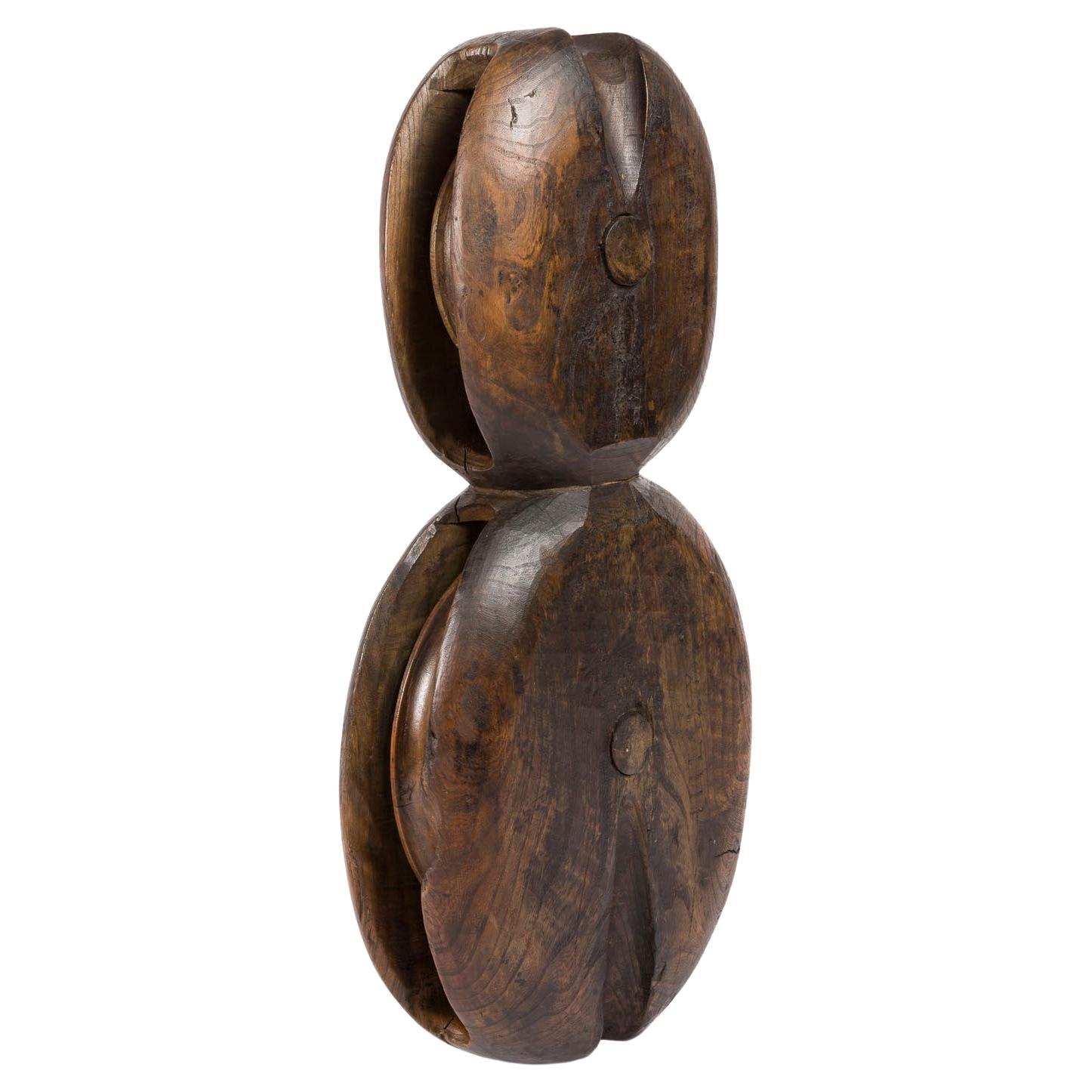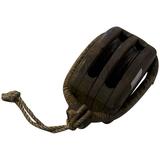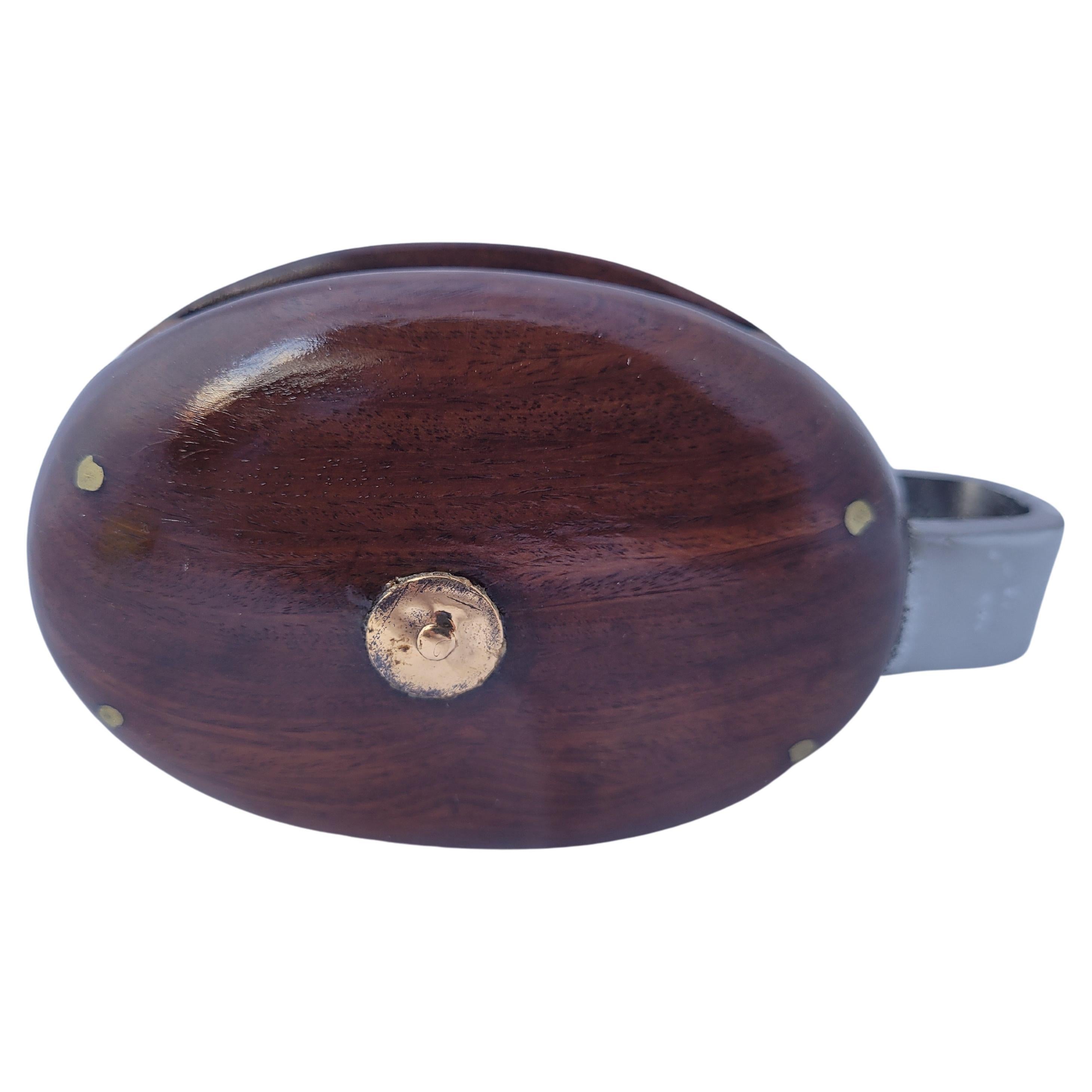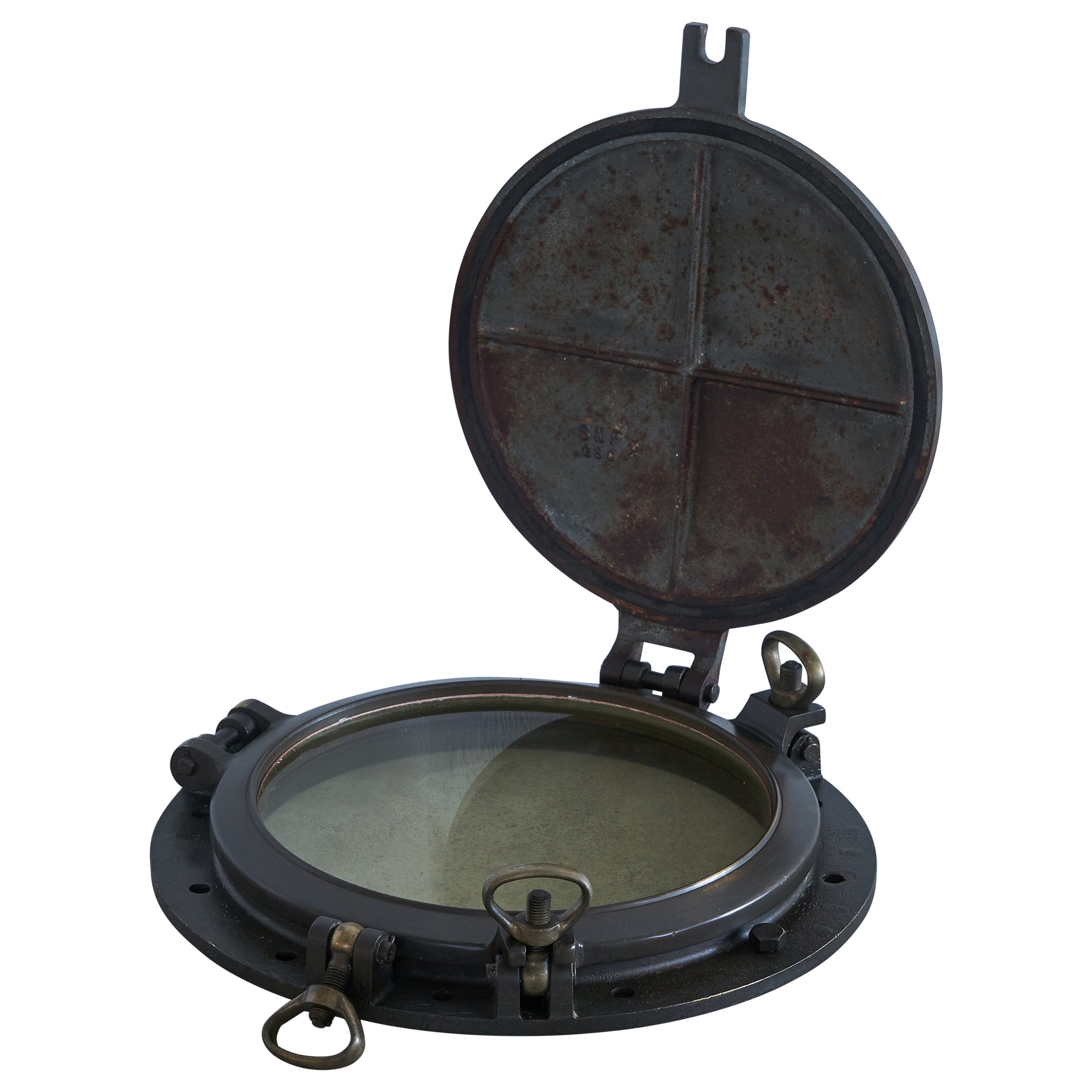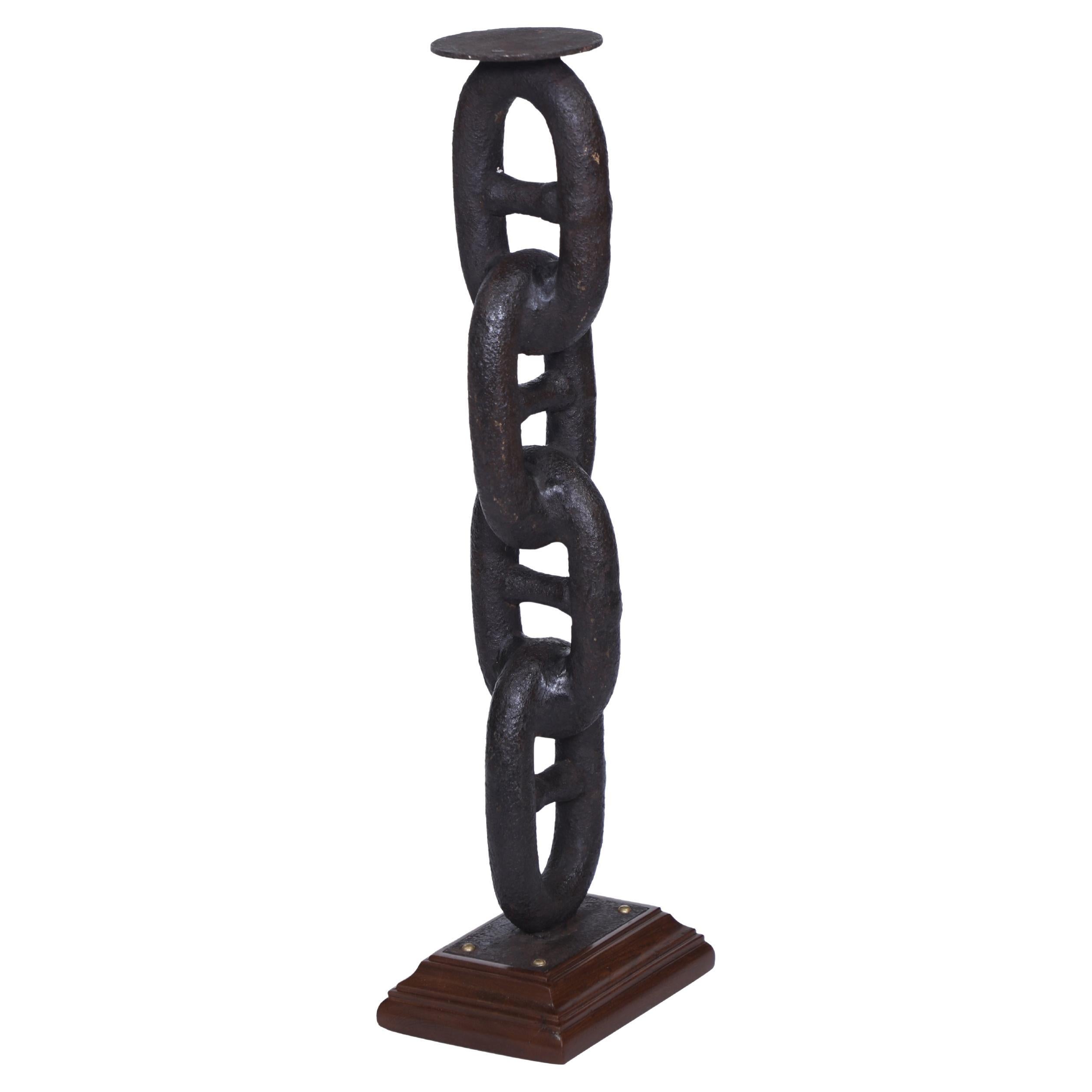Items Similar to 3 sailing ship's oak & iron pulley blocks
Want more images or videos?
Request additional images or videos from the seller
1 of 21
3 sailing ship's oak & iron pulley blocks
About the Item
Three mid 19th century oak and iron Naval pulley blocks, used on sailing ships.
1: Double sheave tackle block with fixed eye. Height: 17 ½ inches.
2: Double sheave stiff swivel hook tackle block. Height: 20 inches.
3: Triple sheave tackle block. Height: 17 ½ inches.
In sailing, a block is a single or multiple pulley. One or a number of sheaves are enclosed in an assembly between cheeks or chocks. In use, a block is fixed to the end of a line, to a spar, or to a surface. A line (rope) is reeved through the sheaves, and maybe through one or more matching blocks at some far end, to make up a tackle. A large sail-powered warship in the 19th century required more than 1,400 blocks of various kinds.
- Dimensions:Height: 17.5 in (44.45 cm)Width: 11 in (27.94 cm)Depth: 8 in (20.32 cm)
- Materials and Techniques:
- Place of Origin:
- Period:
- Date of Manufacture:Mid 19th century
- Condition:Wear consistent with age and use. Minor fading.
- Seller Location:London, GB
- Reference Number:1stDibs: LU1190238848122
About the Seller
5.0
Gold Seller
These expertly vetted sellers are highly rated and consistently exceed customer expectations.
Established in 1961
1stDibs seller since 2015
213 sales on 1stDibs
Typical response time: 1 hour
- ShippingRetrieving quote...Ships From: London, United Kingdom
- Return PolicyA return for this item may be initiated within 14 days of delivery.
More From This SellerView All
- Sailing ship's pulley fiddle blockLocated in London, GBAn early 19th century Naval oak fiddle pulley block, with two wood sheaves. Marked with Roman Numerals: XXVIIII In sailing, a block is a single or multiple pulley. One or a number ...Category
Antique Early 19th Century English Industrial Scientific Instruments
MaterialsOak
- Brass Ship's Inclinometer, circa 1910Located in London, GBA brass ship's inclinometer, circa 1910. Scale in degrees from the vertical to 40° of tilt/list. An inclinometer, or clinometer, is an instrument used for measuring angles of s...Category
Early 20th Century English Nautical Objects
MaterialsBrass
- Wwi Era Ship’s Compass by Heath & CoLocated in London, GBWWI era Patrol type ship’s wet card compass by Heath & Co Ltd, London. 10" gimble mount in oak case, with rotating prism. No: 59. Heath & Co Ltd, Scientific instrument ...Category
Early 20th Century English Scientific Instruments
MaterialsBrass
- Brass Ship's Inclinometer on a Mahogany Back Board, circa 1925Located in London, GBA wall mounted 1920's brass ship's inclinometer in the form of a quadrant and dividers, on a moulded mahogany back board. Scale in degrees from the vertical to 45° of tilt/list. An...Category
Early 20th Century English Nautical Objects
MaterialsBrass
- WWII Ship's Bell from the Minesweeper HMS Queen of Thanet, Dated 1941Located in London, GBA WWII ship's bell from the Royal Navy minesweeper HMS Queen of Thanet, dated 1941. Pendant number J-30. Diameter: 27cm - 10 ½ inches. Height: 28 cm - 11 inches. HMS Queen of Thanet (J30), formerly HMS Melton, was a Racecourse-class minesweeper of the Royal Navy. She was built by William Hamilton & Company in Port Glasgow, Scotland. Melton was launched in March 1916 with the pennant number 898. During World War I she served with the Auxiliary Patrol. Post-war she was transferred to the Mine Clearance Service. Between the wars Melton was sold to Hughes Bolckow Shipbreaking Co in 1927. She was bought by The New Medway Steam Packet Company in 1929 and converted for excursion work on the River Medway and River Thames. She was renamed Queen of Thanet. For the next twelve years she could be found working from Sheerness and Southend. Regular excursions took her to Gravesend, Margate, Clacton and Dover as well as cross-channel voyages to Calais, Boulogne and Dunkirk. In September 1939 she was requisitioned by the Admiralty for minesweeping duties once more and commissioned as HMS Queen of Thanet, pennant number J30. In May 1940 she took part in the Dunkirk evacuation rescuing 4,000 men in four trips. Of that number, 2,000 were transferred from the ex-LNER steamer Prague, after the latter had been damaged by near misses from shells and dive bombers off Gravelines. For Operation Overlord in June 1944 she was stationed at Selsey as the Mulberry Despatch Control Ship. After the war she was returned in 1946 to her owners to recommence excursion work around the Thames Estuary. In January 1949 she was sold to Red Funnel and transferred to Southampton. After refitting at Thorneycroft's yard at Northam she was commissioned in the spring as the company's second Solent Queen. For the next two years she operated excursions from Southampton in the summer. In June 1951 while slipped for survey and repair, she caught fire and was written off as a constructive loss. She was scrapped by Dover Industries Ltd at Dover Eastern Docks in 1951 Literature on HMS Queen of Thanet see: Conway's All The World's Fighting Ships...Category
Mid-20th Century English Historical Memorabilia
MaterialsBronze
- Collection of 12 Perspex Teaching Blocks & LensesBy Griffin & George Ltd.Located in London, GBA collection of twelve Perspex teaching optical blocks and lenses. Various shapes, forms and blocks, convex and concave, a number are backed with a white film. Three have their...Category
Mid-20th Century English Industrial Scientific Instruments
MaterialsAcrylic
You May Also Like
- Authentic Ship's BlockLocated in Norwell, MAAuthentic ship's block, with rope handle. Dimensions: 8.5 x 5 x 6.Category
20th Century Nautical Objects
- Nautical Pulley BlockLocated in Norwell, MAAntique ships pulley block that has a brass sheave and pins. This has been completely restored. It is now a piece of art for your shelf or table. J...Category
Vintage 1920s North American Nautical Objects
MaterialsBrass
- Ship's Chrome Deck Light with Iron BracketLocated in Nantucket, MAA nautical chrome deck light from a working ship, with an iron bracket which is slightly offset but stays center when you hang it. Midcentury. Rewired for A...Category
Mid-20th Century Industrial Chandeliers and Pendants
MaterialsChrome
- Solid Brass and Cast Iron Ship’s PortholeLocated in Tilburg, NLSolid brass and cast iron Ship’s Porthole, early 20th century. Heavy original ship’s porthole, made in solid brass, cast iron and glass. This characteristic object shows a warm overall patina, revealing its age and history on the world’s oceans. The porthole has a glass door, lockable with two brass locks. A solid cast iron shutter...Category
Early 20th Century Unknown Other Windows
MaterialsMetal, Brass
- Large Iron Ship's Chain Converted to StandLocated in Nantucket, MALarge iron ship's chain converted to a stand and as of this writing we have two pieces. Each link measures 4.25" x 7.25" and have been welded together and mounted on a teak base. A...Category
Mid-20th Century Industrial Nautical Objects
MaterialsIron
- Sold Brass Ship's Searchlight Mounted to a Ship's Decking PedestalLocated in Norwell, MAShip's spotlight with meticulously polished and lacquered finish. Glass lens. Mounted on an iron pole with a mahogany and holly replicated ship's decking. The base weighs over 200 po...Category
Vintage 1930s Nautical Objects
MaterialsBrass
